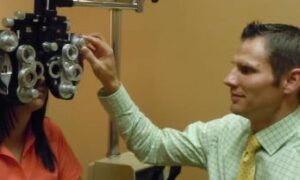By ROB Editors

There are services you can add to your practice that provide both medical eyecare benefits and aesthetic benefits. These services, known as aesthetic optometry, can be a game-changer in patient care and profitability.
Selina R. McGee, OD, FAAO, shared with ROB how she is growing this segment of her practice so that it is on track to comprise 30 percent of her practice revenues. We also provide tips for readers from our editors on using patient financing via the CareCredit credit card to make aesthetic optometry, an out-of-pocket expense, a reality for more patients.
Decide Which Procedures Are Right for Your Practice
“I currently perform Intense Pulse Light (IPL), Radiofrequency (RF) and Neurotoxins/Botox procedures,” Dr. McGee told ROB. “These procedures make up about 10 percent of our overall revenue, but our goal is to get that percentage up to 30 percent over the next three years. There is a great incentive for us to do this, both from a patient care and profitability perspective. All of these procedures are cash-pay only, as none are reimbursable by insurance. I most often present aesthetic optometry-related medical eyecare as three key opportunities: Skin texture improvement (IPL), skin tightening (RF) and eye wrinkle reduction (neurotoxins/Botox).”
How Much Do You Need to Spend to Equip Yourself to Deliver Aesthetic Optometry?
For IPL treatments, Dr. McGee purchased the Optima IPL (Lumenis) for around $50,000. “I made this purchase by taking out a loan requiring monthly payments of around $1,200. I only needed one patient a month to cover that cost,” she explains.
Expanding Access to Aesthetic Optometry
Sponsored Content
Aesthetic optometry can change patients’ lives by making them feel and look better. With so much to offer, you want to believe that all your patients, who could benefit from the treatments, can receive them. Unfortunately, as with many elective treatments, higher out-of-pocket costs can prove to be a barrier. The good news is that you can help bring these services within reach by offering your patients a valuable payment solution.
“We have a payment option in our office that may help. Have you heard of the CareCredit credit card? CareCredit offers promotional financing on purchases of $200 or more allowing approved cardholders to get the treatments they want today and pay for them over time. Would you like to see what your monthly payment could be?”
Paying over time with promotional financing can add significant value to the patient and mean the difference between a patient moving forward immediately or wanting to “think about it”. It is simple for the patient to see if they prequalify and does not impact their credit bureau score. When you help more patients get the care they want, you can boost satisfaction along with practice revenue. —ROB Editors
Dr. McGee says the maintenance fees on instrumentation like the Optima IPL can often be more costly long term than the instrument itself, and is important to factor in when looking at pro forma. “My yearly maintenance contract for the Optima IPL is almost $13,000. So if I treat two patients per month, I break even. I set a goal of one patient per week that I will use the Optima IPL to treat,” she says.
For radiofrequency procedures, Dr. McGee has a TempSure by Cynosure. “I bought this instrument for around $100,000 after taking out a loan with monthly payments of around $1,300 monthly and a maintenance contract that is $8,000 annually,” she points out. “I need two patients per month to break even from this investment. To profit from it, I set a goal of one new patient weekly treated by use of this instrument.”
How Large Do I Have to Go to Benefit Patients?
A practice’s first steps into aesthetic optometry can be small, advises Dr. McGee, and begins with patient education. Build your patients’ knowledge about the cosmetic ingredients that are putting their eye comfort and/or eye health at risk. Many of these ingredients are toxic to the ocular surface.
Another discussion point is how to limit sun damage to the skin around the eyes. “Five to 10 percent of skin cancer occurs on the eyelids even though the skin on our eyelids only comprises 1 percent of the skin on our bodies. I prescribe sun lenses and sunscreen to every patient. Cosmetic lines we sell in the office are Eyes Are the Story and Epionce,” says Dr. McGee. “The ROI is typically 50 percent of the product, meaning our mark-up is 2x, so if we spend $30 on a product, then we sell it for $60. However, this investment in inventory to sell in the office is more about offering something to patients where I control the narrative–keeping them in my practice–rather than on direct profits from sales.”
For patients interested in lengthening lashes, Dr. McGee prescribes Latisse, with caution, as there can be significant side effects that patients are not typically aware of. Upneeq, a prescription medication for acquired blepharoptosis, is also a prescription product available to our patients, she notes. “Upneeq is a great way to achieve results non-invasively for patients who want their eyes to have a more open look.”
As with all optometric procedures and prescriptions, Dr. McGee advises a thoughtful, cautious approach. “Prescribing judiciously and educating patients on potential side effects of aesthetic optometry-related medical eyecare procedures is essential, especially for our dry-eye patients.”
With the right planning, technology, and approach, you can offer aesthetic optometry services that help patients both look and feel better.

























